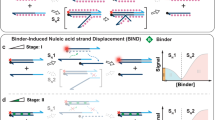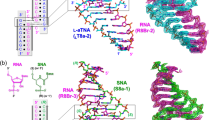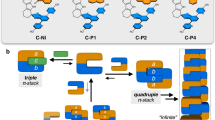Abstract
Numerous essential biomolecular processes require the recognition of DNA surface features by proteins. Molecules mimicking these features could potentially act as decoys and interfere with pharmacologically or therapeutically relevant protein–DNA interactions. Although naturally occurring DNA-mimicking proteins have been described, synthetic tunable molecules that mimic the charge surface of double-stranded DNA are not known. Here, we report the design, synthesis and structural characterization of aromatic oligoamides that fold into single helical conformations and display a double helical array of negatively charged residues in positions that match the phosphate moieties in B-DNA. These molecules were able to inhibit several enzymes possessing non-sequence-selective DNA-binding properties, including topoisomerase 1 and HIV-1 integrase, presumably through specific foldamer–protein interactions, whereas sequence-selective enzymes were not inhibited. Such modular and synthetically accessible DNA mimics provide a versatile platform to design novel inhibitors of protein–DNA interactions.
This is a preview of subscription content, access via your institution
Access options
Access Nature and 54 other Nature Portfolio journals
Get Nature+, our best-value online-access subscription
$29.99 / 30 days
cancel any time
Subscribe to this journal
Receive 12 print issues and online access
$259.00 per year
only $21.58 per issue
Buy this article
- Purchase on Springer Link
- Instant access to full article PDF
Prices may be subject to local taxes which are calculated during checkout






Similar content being viewed by others
References
Nielsen, P. E., Egholm, M., Berg, R. H. & Buchardt, O. Sequence-selective recognition of DNA by strand displacement with a thymine-substituted polyamide. Science 254, 1497–1500 (1991).
Koshkin, A. A. et al. LNA (locked nucleic acids): synthesis of the adenine, cytosine, guanine, 5-methylcytosine, thymine and uracil bicyclonucleoside monomers, oligomerisation, and unprecedented nucleic acid recognition. Tetrahedron 54, 3607–3630 (1998).
Obika, S. et al. Synthesis of 2′-O,4′-C-methyleneuridine and -cytidine. Novel bicyclic nucleosides having a fixed C3′-endo sugar puckering. Tetrahedron Lett. 38, 8735–8738 (1997).
Veedu, R. K. & Wengel, J. Locked nucleic acids: promising nucleic acid analogs for therapeutic applications. Chem. Biodiv. 7, 536–542 (2010).
Nielsen, P. E. Nucleic Acid Backbone Structure Variations: Peptide Nucleic Acids (Wiley, Chichester, 2014).
Rohs, R. et al. Origins of specificity in protein–DNA recognition. Annu. Rev. Biochem. 79, 233–269 (2010).
Luscombe, N. M., Austin, S. E., Berman, H. M. & Thornton, J. M. An overview of the structures of protein–DNA complexes. Genome Biol. 1, reviews001.1 (2000).
Wang, H.-C., Ho, C.-H., Hsu, K.-C., Yang, J.-M. & Wang, A. H.-J. DNA mimic proteins: functions, structures, and bioinformatic analysis. Biochemistry 53, 2865–2874 (2014).
Dryden, D. T. F. DNA mimicry by proteins and the control of enzymatic activity on DNA. Trends Biotechnol. 24, 378–382 (2006).
Yüksel, D., Bianco, P. R. & Kumar, K. De novo design of protein mimics of B-DNA. Mol. BioSyst. 12, 169–177 (2016).
Chenoweth, D. M., Poposki, J. A., Marques, M. A. & Dervan, P. B. Programmable oligomers targeting 5′-GGGG-3′ in the minor groove of DNA and NF-κB binding inhibition. Bioorg. Med. Chem. 15, 759–770 (2007).
Bremer, R. E., Baird, E. E. & Dervan, P. B. Inhibition of major-groove-binding-proteins by pyrrole-imidazole polyamides with an Arg-Pro-Arg positive patch. Chem. Biol. 5, 119–133 (1998).
Ducani, C., Leczkowska, A., Hodges, N. J. & Hannon, H. J. Noncovalent DNA-binding metallo-supramolecular cylinders prevent DNA transactions in vitro. Angew. Chem. Int. Ed. 49, 8942–8945 (2010).
Brabec, V. et al. Metallohelices with activity against cisplatin-resistant cancer cells; does the mechanism involve DNA binding? Chem. Sci. 4, 4407–4416 (2013).
Maher, L. J. III, Wold, B. & Dervan, P. B. Inhibition of DNA binding proteins by oligonucleotide-directed triple helix formation. Science 245, 725–730 (1989).
Azzarito, V., Long, K., Murphy, N. S. & Wilson, A. J. Inhibition of α-helix-mediated protein–protein interactions using designed molecules. Nat. Chem. 5, 161–173 (2013).
Jayatunga, M. K. P., Thompson, S. & Hamilton, A. D. α-Helix mimetics: outwards and upwards. Bioorg. Med. Chem. Lett. 24, 717–724 (2014).
Johnson, L. M. & Gellmann, S. H. α-Helix mimicry with α/β-peptides. Methods Enzymol. 523, 407–429 (2013).
Koert, U., Harding, M. M. & Lehn, J.-M. DNH deoxyribonucleohelicates: self assembly of oligonucleosidic double-helical metal complexes. Nature 346, 339–342 (1990).
Conrad, H. E. Heparin-Binding Proteins (Academic, San Diego, 1998).
Monien, B. H. & Desai, U. R. Antithrombin activation by nonsulfated, non-polysaccharide organic polymer. J. Med. Chem. 48, 1269–1273 (2005).
Rodriguez, R. J. Polyphosphate present in DNA preparations from filamentous fungal species of Collectrichum inhibits restriction endonucleases and other enzymes. Anal. Biochem. 209, 291–297 (1993).
Jiang, H., Léger, J.-M. & Huc, I. Aromatic delta-peptides. J. Am. Chem. Soc. 125, 3448–3449 (2003).
Dolain, C. et al. Solution structure of quinoline- and pyridine-derived oligoamide foldamers. Chem. Eur. J. 11, 6135–6144 (2005).
Qi, T. et al. Solvent dependence of helix stability in aromatic oligoamide foldamers. Chem. Commun. 48, 6337–6339 (2012).
Sánchez-García, D. et al. Nanosized hybrid oligoamide foldamers: aromatic templates for the folding of multiple aliphatic units. J. Am. Chem. Soc. 131, 8642–8648 (2009).
Baptiste, B., Douat-Casassus, C., Laxmi-Reddy, K., Godde, F. & Huc, I. Solid phase synthesis of aromatic oligoamides: application to helical water-soluble foldamers. J. Org. Chem. 75, 7175–7185 (2010).
Qi, T., Deschrijver, T. & Huc, I. Large-scale and chromatography-free synthesis of an octameric quinoline-based aromatic amide helical foldamer. Nat. Protoc. 8, 693–708 (2013).
Liu, Z., Abramyan, A. M. & Pophristic, V. Helical arylamide foldamer: structure prediction by molecular dynamics simulations. New J. Chem. 39, 3229–3240 (2015).
Hu, X. et al. Optimizing side chains for crystal growth from water: a case study of aromatic amide foldamers. Chem. Sci. 8, 3741–3749 (2017).
Hu, X., Dawson, S. J., Nagaoka, A. & Huc, I. Solid-phase synthesis of water-soluble helically folded hybrid α-amino acid/quinoline oligoamides. J. Org. Chem. 81, 1137–1150 (2016).
Lu, H. et al. Ionic polypeptides with unusual helical stability. Nat. Commun. 2, 206 (2011).
Tumey, L. N. et al. The identification and optimization of a N-hydroxy urea series of flap endonuclease 1 inhibitors. Bioorg. Med. Chem. Lett. 15, 277–281 (2005).
Redinbo, M. R., Stewart, L., Kuhn, P., Champoux, J. J. & Hol, W. G. J. Crystal structure of human topoisomerase I in covalent and noncolvalent complexes with DNA. Science 279, 1504–1513 (1998).
Hare, S., Gupta, S. S., Valkov, E., Engelman, A. & Cherepanov, P. Retroviral intasome assembly and inhibition of DNA strand transfer. Nature 464, 232–236 (2010).
Cheng, C., Kussie, P., Pavletich, N. & Shuman, S. Conservation of structure and mechanism between eukaryotic topoisomerase I and site-specific recombinases. Cell 92, 841–850 (1998).
Hazuda, D. J. et al. Inhibitors of strand transfer that prevent integration and inhibit HIV-1 replication in cells. Science 287, 646–650 (2000).
Lesbats, P. et al. In vitro initial attachment of HIV-1 integrase to viral ends: control of the DNA specific interaction by the oligomerization state. Nucleic Acids Res. 36, 7043–7058 (2008).
Hsiang, Y. H., Lihou, M. G. & Liu, L. F. Arrest of replication forks by drug-stabilized topoisomerase I–DNA cleavable complexes as a mechanism of cell killing by camptothecin. Cancer Res. 49, 5077–5082 (1989).
Ishii, K. et al. Mechanism of inhibition of mammalian DNA topoisomerase I by heparin. Biochem. J. 241, 111–119 (1987).
Xiong., S., Zhang, L. & He, Q. Y. Fractionation of proteins by heparin chromatography. Methods Biol. Mol. 424, 213–221 (2008).
Maertens, G. et al. EDGF/p75 is essential for nuclear and chromosomal targeting of HIV-1 integrase in human cells. J. Biol. Chem. 278, 33528–33539 (2003).
Demeulemeester, J., De Rijck, J., Gijsbers, R. & Debyser, Z. Retroviral integration: site matters: mechanisms and consequences of retroviral integration site selection. Bioessays 37, 1202–1214 (2015).
Ciolkowski, M. L., Fang, M. M. & Lund, M. E. A surface plasmon resonance method for detecting multiple modes of DNA–ligand interactions. J. Pharm. Biomed. Anal. 22, 1037–1045 (2000).
Lo, Y. S., Tseng, W. H., Chuang, C. Y. & Hou, M. H. The structural basis of actinomycin D-binding induces nucleotide flipping out, a sharp bend and a left-handed twist in CGG triplet repeats. Nucleic Acids Res. 41, 4284–4294 (2013).
Nguyen, B., Tanious, F. A. & Wilson, W. D. Biosensor-surface plasmon resonance: Quantitative analysis of small molecule–nucleic acid interactions. Methods 42, 150–161 (2007).
Bailly, C. et al. Sequence-specific minor groove binding by bis-benzimidazoles: water molecules in ligand recognition. Nucleic Acids Res. 31, 1514–1524 (2003).
Acknowledgements
This work was supported by the Agence Nationale de la Recherche (project no. ANR-11-BS07-013-01 and project RETROSelect, jcjc2011 program), by the French National Research Agency against AIDS (ANRS, AO2016), by SIDACTION (AO2016, VIH20160721002), by the European Union under the Seventh Framework Programme (grant agreements nos. ERC-2012-AdG-320892 and PEOPLE-2011-IEF-300948) and by the Ligue contre le Cancer (Comité Languedoc Roussillon). The authors thank Mr B. Kauffmann for assistance with crystallographic measurements and resolution, Mr J.-L. Ferrer for beam time and help during data collection on FIP BM30A at the ESRF, and Mr C. Di Primo and Ms L. Minder for assistance with SPR measurements. This work benefited from the facilities and expertise of the Biophysical and Structural Chemistry platform at IECB, CNRS UMS3033, INSERM US001, Bordeaux University, France.
Author information
Authors and Affiliations
Contributions
K.Z. and C.C. contributed equally to this work. K.Z., P.Pr., V.C. and P.P.B. synthesized all new compounds. K.L.-R. synthesized earlier lipophilic versions of the DNA mimics that were critical to the design. K.Z. carried out NMR structural studies. C.C., V.P., S.C. and P.Po. carried out biological assays. M.M. resolved the crystal structures. I.H., V.P., F.G., J.-M.S., S.C. and P.Po. designed the study. I.H. wrote the manuscript. All authors discussed the results and commented on the manuscript.
Corresponding author
Ethics declarations
Competing interests
The authors declare no competing interests.
Additional information
Publisher’s note: Springer Nature remains neutral with regard to jurisdictional claims in published maps and institutional affiliations.
Supplementary information
Supplementary Information
Supplementary Tables, Figures, Data and Methods
Supplementary Video 1
A 3D animation of the solvent accessible surfaces of the structure of a DNA mimic compared to that of B-DNA
Crystallographic data
Crystallographic data Crystallographic data and Structure factors for Boc(mQQ4)8OBn; CCDC 1059495
Crystallographic data
Crystallographic data and Structure factors for Boc(mQQ4)8OTMSE;CCDC 1059497
Crystallographic data
Crystallographic data and Structure factors for Boc(mQQ4)16OBn; CCDC 1059493
Crystallographic data
Crystallographic data and Structure factors for Boc(mQQ5)4OBn CIF; CCDC 1059496
Rights and permissions
About this article
Cite this article
Ziach, K., Chollet, C., Parissi, V. et al. Single helically folded aromatic oligoamides that mimic the charge surface of double-stranded B-DNA. Nature Chem 10, 511–518 (2018). https://doi.org/10.1038/s41557-018-0018-7
Received:
Accepted:
Published:
Issue Date:
DOI: https://doi.org/10.1038/s41557-018-0018-7
This article is cited by
-
Ion transporters: emerging agents for anticancer therapy
Science China Chemistry (2022)
-
A versatile living polymerization method for aromatic amides
Nature Chemistry (2021)
-
A new equilibrium for supramolecular chemists
Nature Chemistry (2021)



